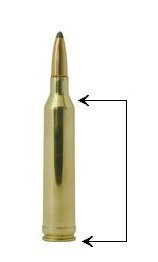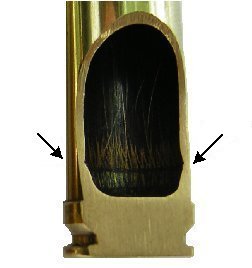Understanding Headspace
. . . . the rest of the story
The
term headspace means the "space" between the "head" of your case and
the breech. This space is set by the firearm manufacturer.
It should to be the minimum clearance to prevent your cartridge
from being pushed forward when the primer gets hit by the firing pin.
Factory "belted" ammo is designed to have the belt stop any
forward movement of the case. Factory "rimmed" ammo is designed
to have the rim stop any forward movement of the case. Factory
"non-rimmed" ammo is designed to have the case shoulder stop any
forward movement of the case. Of course there are some
exceptions with pistol calibers.
Most handloaders understand that handloads should
always have the minimum chamber clearance (at the shoulder).
This is true when reloading any rifle cartridge. Most reloaders
commonly refer to this chamber clearance as "headspace". The
concept is correct, but technically speaking the term "headspace" here
actually makes things a bit confusing. For handloading purposes,
the term headspace means any chamber clearance that allows your
cartridge to move or expand forward. When handloading a
non-rimmed rifle case, the reloader can simply be concerned with
maintaining minimum chamber clearance at the shoulder.
 The picture at the left shows where to measure
chamber clearance when comparing your handloads to a fired case.
This length needs to be resized just short enough to ensure a reliable
fit in your chamber. It also needs to be long enough to prevent
the brass from stretching when it is fired. If there is too much
chamber clearance (at the shoulder), cases can stretch far enough to
crack at the expansion ring. These cracks are a sign of serious
(sometimes dangerous) headspace problems. During firing, cases
expand tightly against the chamber wall. This seals the high
chamber pressure during firing and prevents hot gas from blowing back
through the action. If a case ruptures it can be a safety hazard
for the shooter and for bystanders.
The picture at the left shows where to measure
chamber clearance when comparing your handloads to a fired case.
This length needs to be resized just short enough to ensure a reliable
fit in your chamber. It also needs to be long enough to prevent
the brass from stretching when it is fired. If there is too much
chamber clearance (at the shoulder), cases can stretch far enough to
crack at the expansion ring. These cracks are a sign of serious
(sometimes dangerous) headspace problems. During firing, cases
expand tightly against the chamber wall. This seals the high
chamber pressure during firing and prevents hot gas from blowing back
through the action. If a case ruptures it can be a safety hazard
for the shooter and for bystanders.
The enlarged picture at the right shows a cutaway
view of a belted magnum case that has been reloaded with excessive
chamber clearance at the shoulder. You can see inside the case,
where it has been stretched to the point that it is now very thin.
The arrows show where the case stretching is the worst - at the
expansion ring. If a case is going to crack from a headspace
problem, this is where it will occur. Cases with this much wear
should be discarded, because they are likely to crack or even rupture
on the next firing. You should always examine this area inside
your cases before reloading. Some handloaders use a sharpened
spring hook or even a paperclip to reach in and "feel" the amount of
wear in this area.
 Headspace separation is much more common with
belted magnum calibers. This is because ammunition manufacturers
always make their belted magnum loads to headspace on the belt.
They also leave the shoulder extremely far from contacting the chamber.
This causes the first firing of belted cases to stretch quite
badly. Your "once fired" case is now stretched considerably, and
it is weakened at the expansion ring. The good news is that
further case damage can be kept to a minimum when handloading by
controlling chamber clearance at the shoulder, just as you would for
any rimless caliber. Our Belted Magnum Collet Resizing Die
avoids thinning your brass by resizing the case directly inward, and
then only when a little extra resizing is required.
Headspace separation is much more common with
belted magnum calibers. This is because ammunition manufacturers
always make their belted magnum loads to headspace on the belt.
They also leave the shoulder extremely far from contacting the chamber.
This causes the first firing of belted cases to stretch quite
badly. Your "once fired" case is now stretched considerably, and
it is weakened at the expansion ring. The good news is that
further case damage can be kept to a minimum when handloading by
controlling chamber clearance at the shoulder, just as you would for
any rimless caliber. Our Belted Magnum Collet Resizing Die
avoids thinning your brass by resizing the case directly inward, and
then only when a little extra resizing is required.
The only rifle cartridges
that ever actually required a belt are the .300 H&H Magnum and the
.375 H&H Magnum. Because of their extremely shallow shoulder
angle, these two calibers actually need a belt to prevent the case from
being pushed forward. As you can see on the cutaway case, the
belt is located around the "solid" portion of the case, and it
obviously adds no strength to the case whatsoever. In the
decades that followed, the belt was added to over 20 different calibers
purely for marketing reasons. Firearm manufacturers figured that
if any new magnum caliber didn't have a belt (like the H&H cases)
it would never sell. In fact . . . .
if these 2 calibers weren't such incredible performers (in the early
days) there wouldn't be ANY magnum calibers using a belt today.
Most shooters that reload belted magnums notice a
slight case bulge that forms "just above" the belt. This usually
happens after just 2 or 3 reloadings - wasting perfectly good cases.
Many shooters first assume that their cases aren't getting
resized enough when their handloads begin to stick or even fail to
chamber. Their first thought is that these cases must be too
long. However, it's easy to prove that it's really a case
"width" problem just above the belt. This problem is now easy to
resolve with our Belted Magnum Collet Resizing Die.
In order to resize the body on most belted cases,
your resizing die needs to firmly contact the case, and then forcibly
squeeze downward almost .100" beyond that point. This is required just to reduce .001"
from the diameter of a tapered case. The brass gets plowed
rearward against the belt, preventing any conventional resizing die
from traveling far enough down the case. As the case is
withdrawn, the brass also "springs back" slightly. That's why I
invented the Belted Magnum Collet Resizing Die - to only compress the
brass inward. This ensures a reliable, perfect fit in your
chamber, and it extends the life of your cases.
The case bulge problem is made even worse by reloaders
that don't reduce their chamber clearance at the shoulder. When
a case is fired, it stretches to fill your chamber. This
excessive stretching also weakens your case - just above the belt.
You can read all about our Belted Magnum Collet Resizing Die and our Digital Headspace Gauge on our homepage. These tools both help ensure a reliable fit in your chamber, and provide much longer case life.
